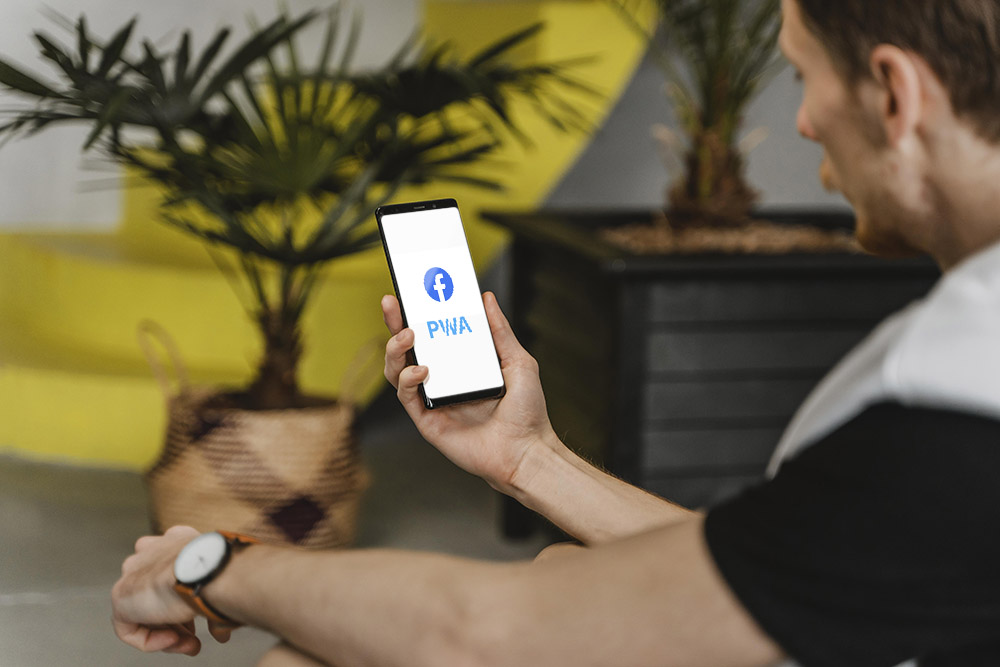The fastest-growing social media platform globally has joined the PWA transformation officially. Our latest article is coming at you with a much-wanted case study of Facebook PWA.
We’ll break down why Facebook needed to switch to a PWA and what results PWA had brought to this giant tech company. Let’s get right in.
Contents
An Overview Of Facebook

In 2004, Harvard drop-out Mark Zuckerberg founded Facebook with a mission to build a community where people from all over the world can connect, share opinions, and interact with each other through posts. And the rest is history.
To this day still, Facebook helps people stay connected, get daily life updates from their friends and family, and discover what’s going on in the world.
It is currently the largest social media platform on this planet, with roughly 2.93 billion monthly active users, data taken from the first quarter of 2022.
Unlike LinkedIn or Twitter with a specific target segment, Facebook grew big because it isn’t limited to any group but reaches out to a variety of people, catering to many types of needs and content, incorporating numerous different media aspects.
The Role Of PWA In The Future
What should we know about PWA when we hear the story of Facebook launching its PWA version? Firstly, it’s about the presence of PWA in the future.
It is not a question of if, but a matter of when website owners will start to integrate or build PWA. Because simply, if Facebook, Twitter, Uber, Tinder, Starbucks, AliExpress, and Alibaba all adopt PWA into their digital strategy, it must be a thing.
Secondly, we know that PWA is still relatively fresh, so its performance can be behind compared to native apps. However 95% of Facebook’s native features can be recreated for PWA, and developers are optimistic about this transformation.
It is predicted to be a tomorrow thing. Almost any app could be built into a PWA already. The list of PWA features keeps extending to native apps and more.
To cut you off from all the inefficient noise around PWA, with buzzwords and bizarre claims, here’s the value it brings to the world.
PWA is born under the concept of making the web a better place to hang out, to make it meaningful to the groups of people that matter.
There’s a huge tendency in the daily app use habits of end-users. Most people use up to a maximum of 6 apps and seriously interact with 2-3 apps only every day.
So, users don’t need more apps as data reveals that their biggest frustration with apps is consuming too much storage. That’s why having users hang out on one single lightweight platform and still creating lasting impacts with them makes native apps fall short.
When users prefer PWA, it saves businesses and developers’ effort and resources to produce a profitable online presence.
It makes more sense to have one seamless experience across devices than having to support 2 separate native apps plus a website.
Besides, building a PWA still works even if brands already own a native app, only that it’s suitable for big names. That would help them attract every prospect possible amid the PWA debut.
Facebook’s Challenges Before PWA Integration
To many people’s surprise and delight, Facebook quit developing its mobile web app in 2020. The original app was said to be not user-friendly enough, and Facebook has been looking for a chance to switch to PWA.
The two divided situations have been shortly closed by PWA’s app-like experience running across browsers. It is evolving in momentum, becoming a feasible alternative to native apps for many in recent years.
Facebook can also tell that the technology is on its way to dominating the digital landscape, especially in ecommerce. However, as a web app, PWA is still new and needs more work on its functionalities.
The Outcomes Of Facebook PWA

About The Design
There’s a slight tweak in the logo design of Facebook PWA and non-PWA when appearing on the home screen. On the desktop, the regular one is shown with a Chrome bookmark at the bottom, while the PWA looks just like a native app icon.
With a non-PWA, you get the good old new tab view with a menu bar and top addresses. The experience differs with PWA when you’ll see a splash screen before the real site emerges and starts to load, exactly like an app. It’s still your device’s browser that handles the work, but it appears in a way that more resembles an app without the top bar.
Facebook PWA runs independently in the overview switcher for you to continue the previous business. Other than that, not many differences are shed on either the content or layout.
About The User Experience
- The loading speed: fast and smooth
- The transition between pages and elements: responsive with instant emergence
- The overall experience: easy, straightforward, and fast
7 Tips To Build A PWA Like Facebook
The KISS Principle (Keep It Simple, Stupid)
The mobile screen is much smaller and consumes far less data and power than the desktop. This means that developers would have less content to work with.
So just keep it simple, essential, and useful. Leave the room for certain spaces rather than driving them to get overwhelmed with your design. Take an A/B test to remove unnecessary elements, resulting in low engagement points.
Using complicated fonts can cost your site much power to load, thus slowing down the process. A rule of thumb is to prioritize default fonts when you can.
Facebook nailed this with the good old Helvetica font so that attention could draw to people’s posts without losing brand identity elements.
Ensure Smooth Navigation
A good priority beforehand is to avoid all web-based interaction factors such as headers or footers at once. Using Facebook on either app or mobile browser, you’ll find everything stays the same where you expect them to be.
Instead of browser functionalities, make it overflow with a no-edge mode and treat your PWA the same way as building a native app.
Although touch gestures should be used with spares, they aren’t necessarily wanted while they are difficult to execute.
Cross-browser Functionality
It is worth considering each browser’s capability with PWA features to evaluate their compatibility in the designing phase.
Chrome and Firefox are the two browsers that support PWA functionalities the most, while Safari still refuses to support service workers in PWA entirely.
The missing of this PWA core technology led to the lack of primal features such as push notifications and offline browsing. You can still see Facebook PWA on all Apple products, but it’s not optimized like on other browsers.
Keep An Offline Mode Snoop
We all remember the infamous Google Dinosaur that keeps us busy and entertained about why the Internet connection is off. The same trick can apply here when the content needs a bit more time to load.
Replacing the loading spinner with something else less frustrating, something that keeps them forgetting about the load will make them think the site is faster than it is.
Another great use to make the loading seem much shorter is Skeleton screens, which shed users a sneak peek into what and what not to expect, at the same time, guiding them towards each point of interest on the page. However, don’t leave out Service Workers, which enable your site to store user-generated data and cache them properly without an Internet connection.
Optimize For SEO
When Google updates algorithms, there is a new set of rules to follow to rank by the search engine. So design your page both in favor of machine crawling and the real visitors behind the screen. Each should be available via a URL.
Without the help of PWA, Facebook posts can hardly appear on all search engines for the relevant keywords. They tend to be highly presented in the top positions.
Here are some points to notice for an SEO-friendly site:
- Server-side rendered content is required for the initial indexing wave, and use it whenever possible. When it isn’t, you can rely on dynamic rendering services provided by third parties.
- Specify canonical URL by canonical tags on each page.
- Avoid cloaking by search bots or serving the same content.
- Make sure your site is loaded fast within 5 secs, increasing on-page time, and highly secured.
Works With Different Types Of Inputs
If you intend to design the trigger to an interaction with a hover effect, make sure users click or touch to activate it. Don’t forget to use the accurate semantic elements and non-semantic HTML, and you’ll get it covered.
Another thing is to keep the area for the keyboard away from the room for messages, which is common when PWA is in landscape view. Facebook PWA did a fantastic job of ensuring its users receive the exact interactions across different devices.
Validate Your PWA With Google’s Lighthouse Tool
When you need to evaluate the performance of your PWA while in the making process or after launch, you can rely on Lighthouse, an open-source tool auditing website from Google. Lighthouse ranks websites based on 5 parameters on a scale of 1 to 100.
Big names always test as their development goes to ensure everything is covered. PWA is also a factor used to classify whether a website is PWA.
And when it’s certain, the PWA will be measured in various terms of speed, security, responsive design, caching, offline performance, indexing, push notifications, and user experience.
Key Takeaways
To bring out the best of both worlds, adopting the best of native apps to websites, thus enabling PWA a huge advantage in the near future. The future of the online landscape compromises the impact of PWA.
The pioneering role of Facebook PWA surely accelerated the PWA revolution while bringing back to them a lightweight experience and a robust platform for users across the globe to join the conversation despite the difference in the Internet connection capacity.
If you’re looking for an expert name that gives you a full sense of reliability to help you take care of the PWA transformation, Tigren is the one you need.
Talk to us today for high-quality premium ecommerce PWA services coming at you for a reasonable price. Start making money sooner and increase your ROI today.

